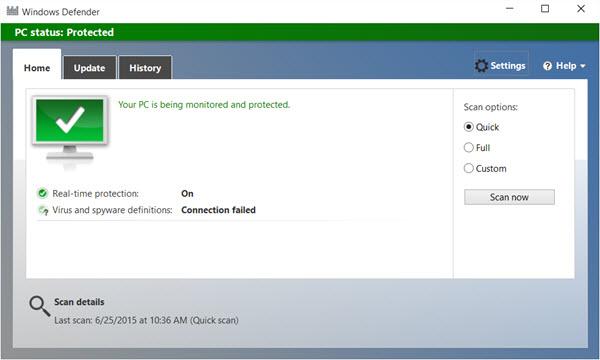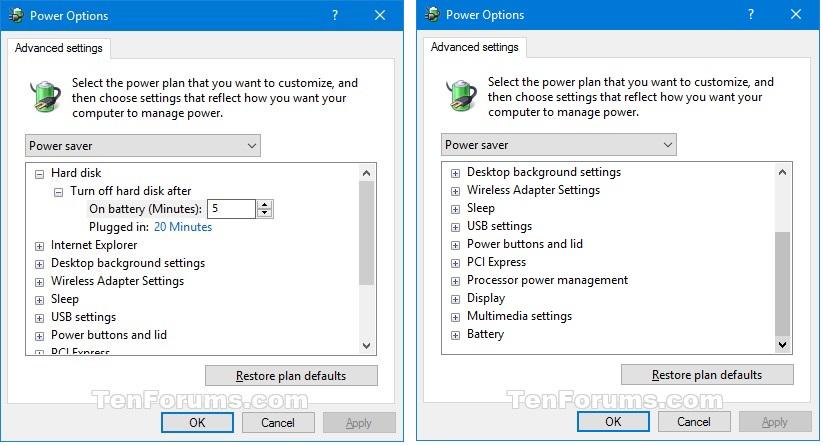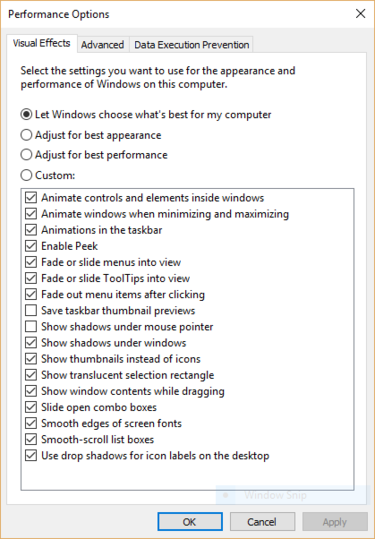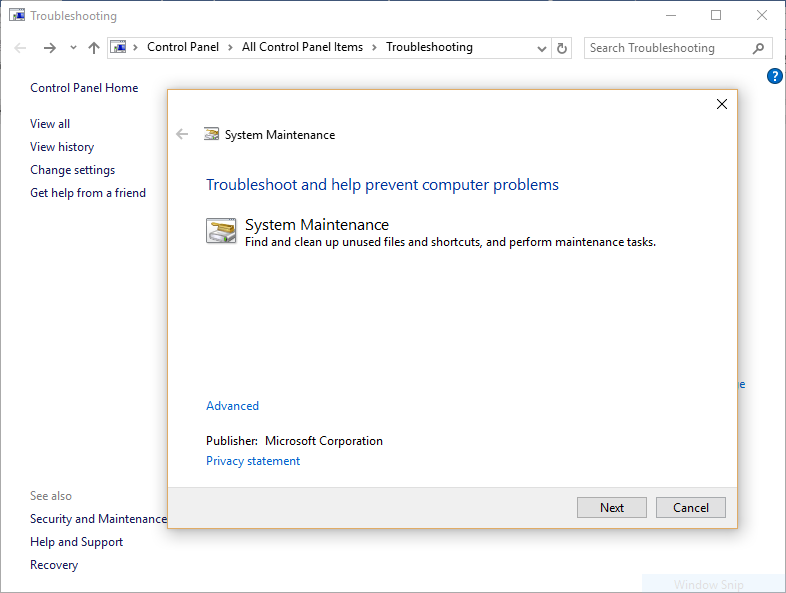- Optimize Windows for better performance
- Try the Performance troubleshooter
- Delete programs you never use
- Limit how many programs run at startup
- Defragment your hard disk
- Clean up your hard disk
- Run fewer programs at the same time
- Turn off visual effects
- Restart regularly
- Add more memory
- Check for viruses and spyware
- Check your computer’s speed
- Change the size of virtual memory
- How to make Windows 10 run faster in 9 easy steps
- How to make Windows 10 run faster in 9 easy steps
- 1. Get your power settings right
- 2. Cut out unnecessary programs running in the background
- 3. Say goodbye to the eye candy!
- 4. Use the troubleshooter!
- 5. Cut out the adware
Optimize Windows for better performance
Here are some tips to help you optimize Windows 7 for faster performance.
Try the Performance troubleshooter
The first thing that you can try is the Performance troubleshooter, which can automatically find and fix problems. The Performance troubleshooter checks issues that might slow down your computer’s performance, such as how many users are currently logged on to the computer and whether multiple programs are running at the same time.
Open the Performance troubleshooter by clicking the Start 
Delete programs you never use
Many PC manufacturers pack new computers with programs you didn’t order and might not want. These often include trial editions and limited-edition versions of programs that software companies hope you’ll try, find useful, and then pay to upgrade to full versions or newer versions. If you decide you don’t want them, keeping the software on your computer might slow it down by using precious memory, disk space, and processing power.
It’s a good idea to uninstall all the programs you don’t plan to use. This should include both manufacturer-installed software and software you installed yourself but don’t want any more—especially utility programs designed to help manage and tune your computer’s hardware and software. Utility programs such as virus scanners, disk cleaners, and backup tools often run automatically at startup, quietly chugging along in the background where you can’t see them. Many people have no idea they’re even running.
Even if your PC is older, it might contain manufacturer-installed programs that you never noticed or have since forgotten about. It’s never too late to remove these and get rid of the clutter and wasted system resources. Maybe you thought you might use the software someday, but never did. Uninstall it and see if your PC runs faster.
Limit how many programs run at startup
Many programs are designed to start automatically when Windows starts. Software manufacturers often set their programs to open in the background, where you can’t see them running, so they’ll open right away when you click their icons. That’s helpful for programs you use a lot, but for programs you rarely or never use, this wastes precious memory and slows down the time it takes Windows to finish starting up.
Decide for yourself if you want a program to run at startup.
But how can you tell what programs run automatically at startup? Sometimes this is obvious, because the program adds an icon to the notification area on the taskbar, where you can see it running. Look there to see if there are any programs running that you don’t want to start automatically. Point to each icon to see the program name. Be sure to click the Show hidden icons button so you don’t miss any icons.
Even after you check the notification area, you might still miss some programs that run automatically at startup. AutoRuns for Windows, a free tool that you can download from the Microsoft website, shows you all of the programs and processes that run when you start Windows. You can stop a program from running automatically when Windows starts by opening the AutoRuns for Windows program, and then by clearing the check box next to the name of the program you want to stop. AutoRuns for Windows is designed for advanced users.
Defragment your hard disk
Fragmentation makes your hard disk do extra work that can slow down your computer. Disk Defragmenter rearranges fragmented data so your hard disk can work more efficiently. Disk Defragmenter runs on a schedule, but you can also defragment your hard disk manually.
Clean up your hard disk
Unnecessary files on your hard disk take up disk space and can slow down your computer. Disk Cleanup removes temporary files, empties the Recycle Bin, and removes a variety of system files and other items that you no longer need.
Run fewer programs at the same time
Sometimes changing your computing behavior can have a big impact on your PC’s performance. If you’re the type of computer user who likes to keep eight programs and a dozen browser windows open at once—all while sending instant messages to your friends—don’t be surprised if your PC bogs down. Keeping a lot of e‑mail messages open can also use up memory.
If you find your PC slowing down, ask yourself if you really need to keep all your programs and windows open at once. Find a better way to remind yourself to reply to e‑mail messages rather than keeping all of them open.
Make sure you’re only running one antivirus program. Running more than one antivirus program can also slow down your computer. Fortunately, if you’re running more than one antivirus program, Action Center notifies you and can help you fix the problem.
Turn off visual effects
If Windows is running slowly, you can speed it up by disabling some of its visual effects. It comes down to appearance versus performance. Would you rather have Windows run faster or look prettier? If your PC is fast enough, you don’t have to make this tradeoff, but if your computer is just barely powerful enough for Windows 7, it can be useful to scale back on the visual bells and whistles.
You can choose which visual effects to turn off, one by one, or you can let Windows choose for you. There are 20 visual effects you can control, such as the transparent glass look, the way menus open or close, and whether shadows are displayed.
To adjust all visual effects for best performance:
Open Performance Information and Tools by clicking the Start 
Click Adjust visual effects
Click the Visual Effects tab, click Adjust for best performance, and then click OK. (For a less drastic option, select Let Windows choose what’s best for my computer.)
Restart regularly
This tip is simple. Restart your PC at least once a week, especially if you use it a lot. Restarting a PC is a good way to clear out its memory and ensure that any errant processes and services that started running get shut down.
Restarting closes all the software running on your PC—not only the programs you see running on the taskbar, but also dozens of services that might have been started by various programs and never stopped. Restarting can fix mysterious performance problems when the exact cause is hard to pinpoint.
If you keep so many programs, e‑mail messages, and websites open that you think restarting is a hassle, that’s probably a sign you should restart your PC. The more things you have open and the longer you keep them running, the greater the chances your PC will bog down and eventually run low on memory.
Add more memory
This isn’t a guide to buying hardware that will speed up your computer. But no discussion of how to make Windows run faster would be complete without mentioning that you should consider adding more random access memory (RAM) to your PC.
If a computer running Windows 7 seems too slow, it’s usually because the PC doesn’t have enough RAM. The best way to speed it up is to add more.
Windows 7 can run on a PC with 1 gigabyte (GB) of RAM, but it runs better with 2 GB. For optimal performance, boost that to 3 GB or more.
Another option is to boost the amount of memory by using Windows ReadyBoost. This feature allows you to use the storage space on some removable media devices, such as USB flash drives, to speed up your computer. It’s easier to plug a flash drive into a USB port than to open your PC case and plug memory modules into its motherboard.
Check for viruses and spyware
If your PC is running slowly, it’s possible that it’s infected with a virus or spyware. This is not as common as the other problems, but it’s something to consider. Before you worry too much, check your PC using antispyware and antivirus programs.
A common symptom of a virus is a much slower-than-normal computer performance. Other signs include unexpected messages that pop up on your PC, programs that start automatically, or the sound of your hard disk constantly working.
Spyware is a type of program that’s installed, usually without your knowledge, to watch your activity on the Internet. You can check for spyware with Windows Defender or other antispyware programs.
The best way to deal with viruses is to prevent them in the first place. Always run antivirus software and keep it up to date. Even if you take such precautions, however, it’s possible for your PC to become infected.
Check your computer’s speed
If you try these tips and your computer is still too slow, you might need a new PC or some hardware upgrades, such as a new hard disk or faster video card. There’s no need to guess the speed of your computer, however. Windows provides a way to check and rate your PC’s speed with a tool called the Windows Experience Index.
The Windows Experience Index rates your computer on five key components and gives you a number for each, as well as an overall base score. This base score is only as good as your worst-performing component subscore. Base scores currently range from 1 to 7.9. If your PC is rated lower than 2 or 3, it might be time to consider a new PC, depending on what tasks you want to do with your computer.
Change the size of virtual memory
If you receive warnings that your virtual memory is low, you’ll need to increase the minimum size of your paging file. Windows sets the initial minimum size of the paging file equal to the amount of random access memory (RAM) installed on your computer, and the maximum size equal to three times the amount of RAM installed on your computer. If you see warnings at these recommended levels, then increase the minimum and maximum sizes.
Open System by clicking the Start 
In the left pane, click Advanced system settings 
On the Advanced tab, under Performance, click Settings.
Click the Advanced tab, and then, under Virtual memory, click Change.
Clear the Automatically manage paging file size for all drives check box.
Under Drive [Volume Label], click the drive that contains the paging file you want to change.
Click Custom size, type a new size in megabytes in the Initial size (MB) or Maximum size (MB) box, click Set, and then click OK.
Note: Increases in size usually don’t require a restart for the changes to take effect, but if you decrease the size, you’ll need to restart your computer. We recommend that you don’t disable or delete the paging file.
How to make Windows 10 run faster in 9 easy steps
Windows 10 is pretty fast out of the box, but you can make it even faster. How? For starters, you can eliminate those “extras” inside of the operating system that make it look great but are not exactly necessary. What’s more, there are many processes designed to make Windows more efficient, but your way of working may not require all of these cumbersome processes. Why not throw those out, too?
In this how-to, we look at all of the ways that you can make Windows 10 run faster on your PC. Follow these nine steps to attain performance nirvana.
How to make Windows 10 run faster in 9 easy steps
1. Get your power settings right
Windows 10 automatically runs on a Power Saver Plan. While this may save money on your electricity bill, it does come at the cost of your computer’s performance.
In order to get around this, head to Control Panel, select Hardware and Sound and go into the Power Options. You’ll then be presented with two more options, which are called Balanced and Power Saver.
However, if you click the down arrow beside Additional Options, you’ll be able to select the High-Performance setting. Sure, this might use up a little more juice, but it’s the first step to getting Windows 10 to run even faster on your PC.
2. Cut out unnecessary programs running in the background
You may not even be aware of this, but when you start Windows 10, a number of programs are opened and run right away. Of course, this operating system practice has been developed to make things easier for users. But, it is often more of an obstruction that can make a computer feel a bit sluggish.
To stop Windows 10 from doing this, you’ll need to enter the Task Manager, which you do by holding down Ctrl+Shift+Escape. The Task Manager will look like this:
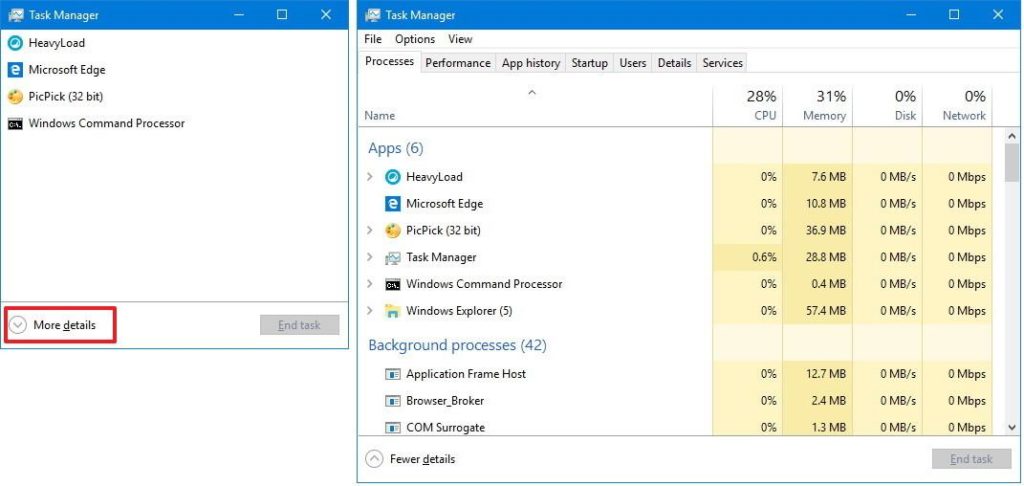
Of course, the more processes you can do without, the faster your copy of Windows 10 will run. From a practical point of view, you can also enable any programs you’d like to have up and running by the time you log on.
3. Say goodbye to the eye candy!
Sure, all of those cute animations make Windows 10 look amazing. Such visual magic, however, comes at a cost, as each shadow and effect takes its toll on overall system performance. In order to cut down on such extravagances and make some tweaks, you’ll have to carry out a couple of simple procedures.
The first is to head the search box and enter the word sysdm.cpl. Doing so conjures up the System Properties list. As can be seen in the image below, you’ll then have a range of options to either keep or get rid of the animations that slow down Windows 10.
Don’t think that things will suddenly turn bleak once you’ve switched off these visual attractions; just be aware that a few of the cute tricks you’ve become used to might not be available anymore!
4. Use the troubleshooter!
Yes, you read that correctly. In an article that promises to make Windows 10 run faster, we’re telling you to ask the operating system a few questions! The reason for this is that Microsoft has developed a more sophisticated help center that can tell you exactly why your computer is running a little slowly.
More precisely, what you’ll need to do is head to the search bar and look up Run Maintenance Tasks.
This will identify all of the surplus shortcuts and data that you don’t use in your day to day activities and get rid of them. Really, it’s a win for you because you’ll get an increased performance at the cost of absolutely nothing.
As you might expect, by cutting out all of the unnecessary processes going on under the hood, Windows 10 will start to run faster immediately.
5. Cut out the adware
While a lot of the techniques on this list identify the ways in which Windows 10 can be directly tweaked to run faster, there are additional processes outside direct control of the OS that cause things to slow down. Adware and bloatware, for example, are like infections that install themselves on your computer and slowly eat away at your performance.
Removing them may sound like a tough task, but it’s actually fantastically easy. All you’ll need to do is search for Windows Defender and run a scan. By using this software that comes with Windows 10, you’ll be able to easily locate and remove any viruses which are eating away at your computer’s performance.

